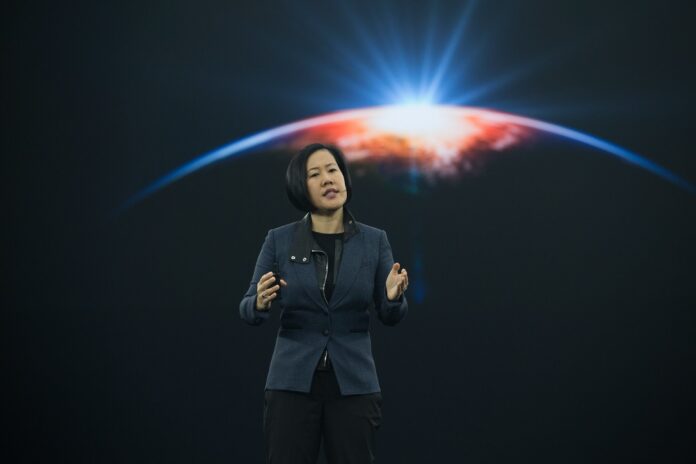SAN DIEGO—Now that it has connected much of the world’s enterprise networks, Cisco is working on connecting other critical enterprise assets: employees and customers.
Cisco celebrated its 30th annual Live user conference here last week by talking up its new “cognitive collaboration” strategy that spans Webex tools for video meetings to contact center interactions.
While cognitive implies plenty of artificial intelligence (AI) and machine learning will be included, the strategy stresses the importance of making meetings and interactions simple to set up, reliable and secure.
The new Webex features and the vision of video agility are partly a response to Cisco’s bulky Telepresence system as well as to the changing nature of business and increasingly decentralized workforces. Employees expect to be able to join a meeting wherever they are.
“You’re going to see us hold to the promise of building bridges and integrations—no more islands,” said Amy Chang (pictured), senior vice president of Cisco Collaboration, who has emerged as a force behind the new collaborative vision since Cisco acquired her startup, Accompany, last year. “Context and intelligence are being slip-streamed into the product, building highly personalized experiences, with everything brought to you on a silver platter.”
New features of Webex that Cisco announced earlier this spring include the AI features that make up that platter. Proactive Join will ask a user if they’d like to join their meeting when they walk into a meeting room. People Insights surfaces information about each person in the meeting, and facial recognition automatically identifies each person.
Citizens Financial Group recently completed a move to Webex as part of an effort to modernize its operations and transform its workplace, said Erik Johnson, senior vice president of Workplace Technology for the New England-based institution.
A new 3,000-employee, five-building campus features 150 conference rooms, all of which are video-enabled by Webex, he said at Cisco’s Workplace Transformation Summit here. “There are no projectors. Everything is Webex digital in the cloud,” he said, adding that the company is logging 10 million minutes of meetings a month.
“We are getting close to realizing the vision of a truly unified and connected bank,” Johnson said. “We can connect a customer interaction in a branch to a relationship manager anywhere.”
Collaboration in the Call Center
Cisco is also making major cognitive investments into its Contact Center Enterprise product, as the use of AI is revealing new ways to get value from the old-fashioned call center. Where legacy contact center interactions are reactive, often lacking in context, and measured in call time or call volume, new tools can enable them to be “pre-emptive, contextual and measured in business outcomes,” said Vasili Triant, vice president and general manager of Cisco Contact Center.
Contact centers always collected a lot of data, Triant said in an interview with eWEEK, but that data was seldom accessible. “There’s lots of dark data in contact centers,” he said. “We need to find it and light it up [for the call center customer service rep].”
Cisco’s solution would automate several manual processes by using natural language processing that transcribes a customer conversation in real time and surfaces actions that a rep can take to satisfy the customer. “We are trying to change the business process along with the technology,” Triant said. “Part of the selling process is to get them to make changes.”
Customer Connections
Around the show floor at Cisco Live, it was evident that networking is about more than connecting switches and routers; it is also an important part of improving customer experiences, say Cisco and its partners. That customer satisfaction goes all the way down to the bits and bytes that flow through the wires and airwaves of the internet.
For instance, network monitoring vendors such as AppNeta are helping customers use their network monitoring tools with an eye toward customer satisfaction. Marriott International uses the technology to get more visibility into its hotels’ branch networks, which tend to be ignored in this day of cloud and software-as-a-service (SaaS) applications, said Matt Stevens, AppNeta’s CEO. By doing deep-packet inspection, the networks can automatically give priority to customer services applications over nonessential apps.
Likewise, Google’s recent outage showed that major cloud failures can impact customers down the line. So, businesses using the cloud need to be more aware of their providers’ policies for responding to outages, said Angelique Medina, director of product marketing for SD-WAN monitoring company ThousandEyes and author of an analysis of the Google outage.
“Users should ask, where do I fall into these policy buckets, because it’s not clear based on the type of traffic [we analyzed],” she said. “Users also need to have redundancy across regions, not just availability zones.”
As Cisco CEO Chuck Robbins said in his opening keynote at Cisco Live: “It’s not 1989 any longer.” Users and businesses and their customers have come to expect more from the internet—more speed, more reliability, more better experiences, more of everything. Cisco is betting that it can meet that challenge.
Scot Petersen is a technology analyst at Ziff Brothers Investments, a private investment firm. He has an extensive background in the technology field. Prior to joining Ziff Brothers, Scot was the editorial director, Business Applications & Architecture, at TechTarget. Before that, he was the director, Editorial Operations, at Ziff Davis Enterprise. While at Ziff Davis Media, he was a writer and editor at eWEEK. No investment advice is offered in his blog. All duties are disclaimed. Scot works for a private investment firm, which may at any time invest in companies whose products are discussed in this blog, and no disclosure of securities transactions will be made.
